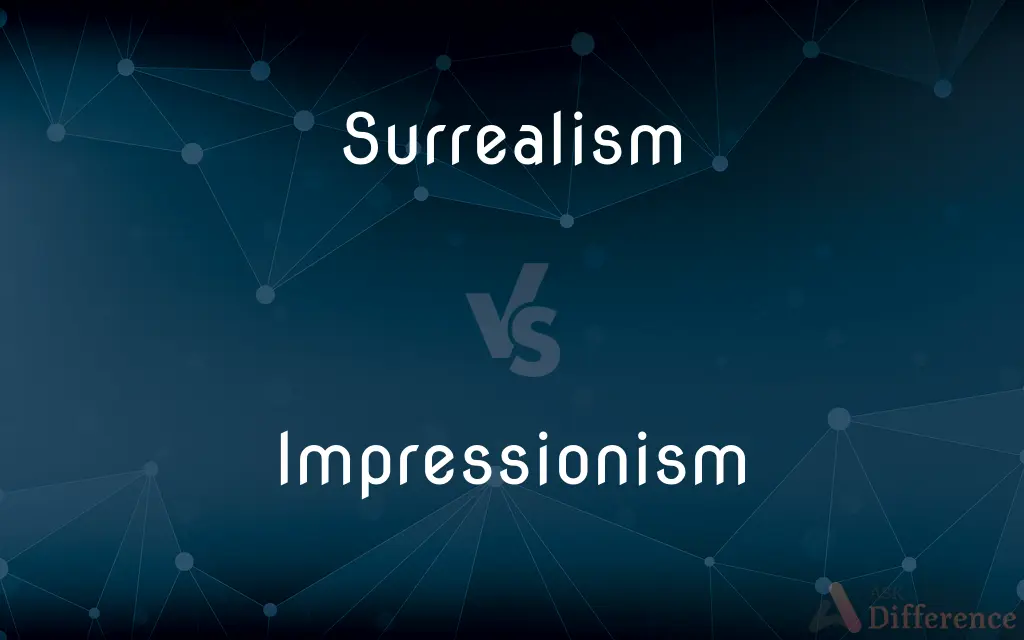Surrealism vs. Impressionism — What's the Difference?
By Fiza Rafique & Maham Liaqat — Updated on April 24, 2024
Surrealism focuses on dream-like, subconscious expressions while Impressionism captures fleeting moments and natural light effects.

Difference Between Surrealism and Impressionism
Table of Contents
ADVERTISEMENT
Key Differences
Surrealism is an art movement that emphasizes irrational, dream-like scenes and subconscious expressions, often using unexpected juxtapositions. Whereas, Impressionism focuses on capturing fleeting moments and the effects of natural light on subjects, aiming to evoke the sensation of a particular time and place.
Surrealist artists, such as Salvador Dalí, often employed techniques like automatism and bizarre imagery to explore the unconscious mind. On the other hand, Impressionist painters like Claude Monet used loose brushwork and attention to light variations to capture an impression of a moment, often in outdoor settings.
While Surrealism delves into the abstract and explores a reality beyond the ordinary, Impressionism seeks to depict the transient effects of light and color in the everyday world. This fundamental difference in subject matter reflects their distinct philosophical foundations.
Surrealism emerged in the early 20th century as a reaction against the rationalism that was believed to have caused the horrors of World War I. In contrast, Impressionism developed in the late 19th century France, partly as a response to the rapid modernization of society and the desire to represent contemporary life.
The techniques in Surrealism often involve elements of surprise and unexpected contradictions, creating a sense of the uncanny. Whereas, Impressionism uses rapid brush strokes and a lighter palette to capture the essence of a scene rather than its detailed reality.
ADVERTISEMENT
Comparison Chart
Time Period
Early 20th century
Late 19th century
Key Techniques
Automatism, unexpected juxtapositions
Loose brushwork, emphasis on light and color
Subject Matter
Dream-like scenes, exploration of the unconscious
Daily life, effects of natural light
Philosophical Foundations
Anti-rationalism, exploration of the subconscious
Immediate experiences, depiction of modern life
Notable Artists
Salvador Dalí, René Magritte
Claude Monet, Edgar Degas
Compare with Definitions
Surrealism
Surrealism values the unpredictable and bizarre as a way to explore the unconscious mind.
Automatic drawing, where the hand freely moves across the paper, was a Surrealist technique to unlock creativity.
Impressionism
Art characterized by visible brush strokes, open composition, and emphasis on light in its changing qualities.
Edgar Degas often painted ballet dancers showing movement with blurred edges.
Surrealism
An artistic movement aimed at expressing imaginative dreams and visions free from conscious rational control.
Salvador Dalí's melting clocks in The Persistence of Memory is a famous example of Surrealism.
Impressionism
A movement that sought to capture a slice of life, eschewing the traditional themes of history and mythology.
Renoir’s Bal du moulin de la Galette shows Parisians enjoying a Sunday afternoon dance.
Surrealism
A style of art where artists combine unrelated images or events in a very strange and dreamlike way.
A typical Surrealist painting might feature a train emerging from a fireplace.
Impressionism
Art that often portrays leisure activities and landscapes with a transient sense of the scenes.
Pissarro's paintings frequently depict rural and urban settings under different weather conditions.
Surrealism
The movement that believes in the liberation of the mind by emphasizing the critical and imaginative powers of the subconscious.
André Breton’s Surrealist manifestos outlined the principles of the movement.
Impressionism
A 19th-century art movement that captures momentary effects of light and color.
Monet’s Impression, Sunrise gave Impressionism its name.
Surrealism
Art that utilizes elements of surprise and unexpected juxtapositions.
René Magritte's The Lovers features two people kissing while their heads are covered by cloths.
Impressionism
Impressionism focuses on the natural elements and how they interact at different times of day and in various conditions.
Monet's series of Water Lilies depict the play of light and shadow.
Surrealism
Surrealism was a cultural movement which developed in Europe in the aftermath of World War I and was largely influenced by Dada. The movement is best known for its visual artworks and writings and the juxtaposition of distant realities to activate the unconscious mind through the imagery.
Impressionism
Impressionism is a 19th-century art movement characterized by relatively small, thin, yet visible brush strokes, open composition, emphasis on accurate depiction of light in its changing qualities (often accentuating the effects of the passage of time), ordinary subject matter, inclusion of movement as a crucial element of human perception and experience, and unusual visual angles. Impressionism originated with a group of Paris-based artists whose independent exhibitions brought them to prominence during the 1870s and 1880s.
Surrealism
A literary and artistic movement of the 1900s that attempts to express the workings of the subconscious and is characterized by fantastic imagery and incongruous juxtaposition of subject matter.
Impressionism
Often Impressionism A theory or style of painting originating and developed in France during the 1870s, characterized by concentration on the immediate visual impression produced by a scene and by the use of unmixed primary colors and small strokes to simulate actual reflected light.
Surrealism
Literature or art produced in this style.
Impressionism
A literary style characterized by the use of details and mental associations to evoke subjective and sensory impressions rather than the re-creation of objective reality.
Surrealism
An artistic movement and an aesthetic philosophy that aims for the liberation of the mind by emphasizing the critical and imaginative powers of the subconscious.
Impressionism
(Music) A style of art music of the late 1800s and early 1900s, often evoking a dreamy mood and characterized by modal or whole-tone scales, rich and often dissonant harmonies in unconventional progressions, and the avoidance of traditional forms.
Surrealism
A 20th century movement of artists and writers (developing out of Dadaism) who used fantastic images and incongruous juxtapositions in order to represent unconscious thoughts and dreams
Impressionism
(arts) a movement in art characterized by visible brush strokes, ordinary subject matters, and an emphasis on light and its changing qualities
Impressionism
(music genre) a style that avoided traditional harmony, and sought to invoke the impressions of the composer
Impressionism
(poetry) a style that used imagery and symbolism to portray the poet's impressions
Impressionism
The theory or method of suggesting an effect or impression without elaboration of the details; - a disignation of a recent fashion in painting and etching.
Impressionism
A school of late 19th century French painters who pictured appearances by strokes of unmixed colors to give the impression of reflected light
Common Curiosities
Who are some key Impressionist painters?
Claude Monet and Edgar Degas are among the most famous Impressionist painters.
What is Impressionism?
Impressionism is an art movement focusing on capturing fleeting moments and the effects of light and color.
Did Impressionism influence other art movements?
Yes, Impressionism influenced various movements including Post-Impressionism and the Modernist art movement.
What techniques are characteristic of Impressionism?
Impressionists typically use loose brushwork and pay close attention to light variations to capture the essence of moments.
Can you name some notable Surrealist artists?
Notable Surrealists include Salvador Dalí and René Magritte.
What inspired the Impressionist movement?
Impressionism was partly inspired by a desire to represent contemporary life and its rapid changes.
What is Surrealism?
Surrealism is an artistic movement that emphasizes surreal, bizarre, and dream-like scenes to explore the unconscious mind.
How do Surrealist artists create their works?
Surrealist artists use techniques like automatism and unexpected juxtapositions to express the workings of the unconscious mind.
How does Surrealism differ from Impressionism in its depiction of reality?
Surrealism explores abstract and bizarre realities, while Impressionism captures everyday scenes influenced by natural light.
What kind of scenes are typical in Impressionist art?
Typical scenes in Impressionist art include landscapes, urban settings, and daily life activities.
What is a common technique in both Surrealism and Impressionism?
Both movements utilize innovative techniques, but while Surrealism employs dream-like juxtapositions, Impressionism focuses on the effects of light and color.
What philosophical foundations underpin Surrealism?
Surrealism is grounded in anti-rationalism and a belief in the power of the subconscious mind.
What is the importance of light in Impressionism?
In Impressionism, light is crucial as it affects the color and impression of the scenes depicted.
How did Surrealism react to contemporary events of its time?
Surrealism emerged as a reaction against the rationalism that led to the tragedies of World War I.
What role does the subconscious play in Surrealist art?
The subconscious is central in Surrealist art, as it is used to unlock deeper truths and explore creativity.
Share Your Discovery

Previous Comparison
Cousin vs. Uncle
Next Comparison
Each vs. PieceAuthor Spotlight
Written by
Fiza RafiqueFiza Rafique is a skilled content writer at AskDifference.com, where she meticulously refines and enhances written pieces. Drawing from her vast editorial expertise, Fiza ensures clarity, accuracy, and precision in every article. Passionate about language, she continually seeks to elevate the quality of content for readers worldwide.
Co-written by
Maham Liaqat













































